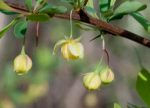 Japanese barberry is a thorny, deciduous shrub growing 3-6’ tall and a member of the barberry family, Berberidaceae, that also includes heavenly bamboo (Nandina), Oregon grape (Mahonia), and barronwort (Epimedium). The obvate green leaves are up to 1 ¼” long and turn yellow to red in the fall. Pendent clusters of pale yellow flowers appear in spring and give way to small red berries that persist into winter and are attractive to birds. Plants are very adaptable and tolerate shade, heat, drought, and urban conditions. They respond well to pruning and are especially useful for barrier hedges. Several cultivars are available that vary most significantly in height and color of foliage. Japanese barberry is native to Japan but was introduced into the US in 1875 as an ornamental and as a replacement for common barberry (B. vulgaris) which is a host for black stem rust of wheat. Plants form dense stands that compete with native vegetation in open woods woodland borders, pastures, fields, and disturbed areas such as waste lots, and have become invasive from Maine too Manitoba, south to Georgia and Kansas due to their high reproductive capacity and the fact that they are avoided by browsing wildlife.
Japanese barberry is a thorny, deciduous shrub growing 3-6’ tall and a member of the barberry family, Berberidaceae, that also includes heavenly bamboo (Nandina), Oregon grape (Mahonia), and barronwort (Epimedium). The obvate green leaves are up to 1 ¼” long and turn yellow to red in the fall. Pendent clusters of pale yellow flowers appear in spring and give way to small red berries that persist into winter and are attractive to birds. Plants are very adaptable and tolerate shade, heat, drought, and urban conditions. They respond well to pruning and are especially useful for barrier hedges. Several cultivars are available that vary most significantly in height and color of foliage. Japanese barberry is native to Japan but was introduced into the US in 1875 as an ornamental and as a replacement for common barberry (B. vulgaris) which is a host for black stem rust of wheat. Plants form dense stands that compete with native vegetation in open woods woodland borders, pastures, fields, and disturbed areas such as waste lots, and have become invasive from Maine too Manitoba, south to Georgia and Kansas due to their high reproductive capacity and the fact that they are avoided by browsing wildlife.
Type: Deciduous shrub
Outstanding Feature: Fall coloration, thorns
Form: Arching
Growth Rate: Moderate
Bloom: Pendant clusters of pale yellow flowers bloom in spring
Size: 3-6’ H x 4-7’ W
Light: Full sun but tolerate some shade
Soil: Average, dry to medium, well-drained
Hardiness: Zones 4-8
Care: Low maintenance
Pests and Diseases: None of significance but susceptible to bacterial leaf spot, anthracnose, root rots, wilt, aphids, barberry webworm, and scale.
Propagation: Seed, semi-hardwood cuttings